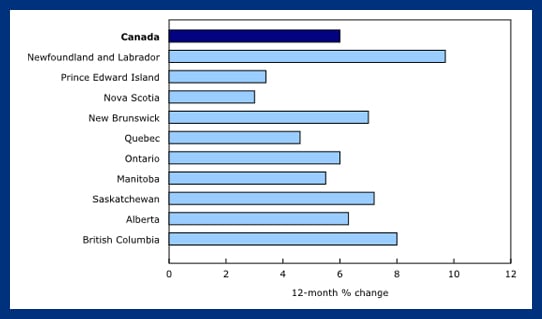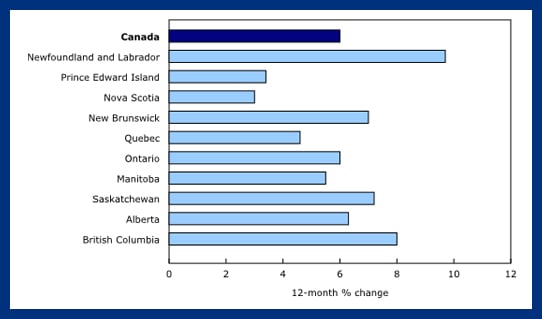Food and shelter continue to drive inflation
While falling gasoline prices led to a moderate 1.6% annual inflation rate in September, Statistics Canada revealed that October’s annual inflation rate had ticked back up to 2%.
Even though gas prices continue to fall, food and shelter make up such a large amount of what Canadians spend, they dominate the overall inflation picture. Shelter makes up 28.6% of what Canadians spend, and food has now increased to 16.7%. Consequently, while items like clothing and transportation aren’t really going up, food and shelter pull up the annualized average to 2%. The inflation rate for shelter is coming down slowly, but it continues to be a pain point for many Canadians.
| CPI tems | September 2024 | October 2024 |
|---|---|---|
| All | 1.6% | 2.0% |
| Food | 2.8% | 3.0% |
| Shelter | 5.0% | 4.8% |
| Household operations, furnishings and equipment | -0.2% | -0.1% |
| Clothing and footwear | -4.4% | -2.3% |
| Transportation | -1.5% | 0.2% |
| Health and personal care | 3.1% | 3.1% |
| Recreation, education and reading | 0.0% | -0.9% |
| Alcoholic beverages, tobacco products and recreational cannabis | 3.0% | 3.0% |
While prices for services rose at an annual rate of 3.6% in October, prices for goods were up just 0.1%. (Generally speaking, service would include items such as haircuts, housekeeping services, or dental care. Goods would be everything from TVs to shoes.) Property tax increases are always a focus of the October inflation report, since that is when they are recalculated each year. This year, property taxes rose 6% (compared to a 4.9% increase last year).

This inflation increase is going to make it harder for the Bank of Canada (BoC) to justify large interest rate cuts going forward. If inflation remains stubbornly high, we may see the BoC scale back on its forecasted interest rate cuts. Given the U.S. election results that we commented on last week, “higher for longer” interest rates may very well be the new probable path forward.
Canada’s best dividend stocks
Missing the Target
One of the biggest surprises on Wall Street this week was the massive earnings miss by Target. Shares were down 21% on Wednesday after Target revealed it is having difficulty generating sales revenue despite a heavy discounting strategy.
American retailer earnings highlights
It’s been a big week for big U.S. corporate retailers. All numbers below are in U.S. dollars.
- Walmart (WMT/NYSE): Earnings per share of $0.58 (versus $0.53 predicted). Revenue of $169.59 billion (versus $167.72 billion predicted).
- Target (TGT/NYSE): Earnings per share of $1.85 (versus $2.30 predicted). Revenue of $25.45 billion (versus $25.21 billion estimate).
- Lowe’s (LOW/NYSE): Earnings per share of $2.89 (versus $2.82 predicted), and revenues of $23.59 billion (versus $23.91 billion predicted).
Target CEO Brian Cornell blamed the bad quarter on “lingering softness in discretionary categories,” as well as poor inventory management. Target incurred increased shipping costs as it paid high fees to rush goods into its warehouses ahead of the port strike in October. These costs, combined with flatlining demand, led to a costly inventory build-up. Shares are now at a 52-week low.
In stark contrast to the large earnings miss by Target, its big blue competitor continued to show why it is best-in-class. Walmart beat earnings—yet again—and showed the financial consistency that investors love. Aside from better inventory management, the biggest reason for Walmart’s higher sales numbers likely relate to the different product mixes of the two retailers. At this point, Walmart is a massive grocery store with a large everything-else-store attached, as 60% of Walmart’s U.S. business is groceries (while only 23% of Target’s sales are groceries).
While online sales were up 10% for Target, they were up 22% for Walmart. Walmart Chief Financial Officer John David Rainey stated that customers continued to be “focused on price and value.” He added that tariffs could force Walmart to increase prices, but that it was too soon to say what merchandise would feel the tariff pinch the hardest.
Shares of Lowe’s dropped about 3% on Tuesday when it announced an earnings beat, but a slight miss on revenues. CEO Marvin Ellison said that management believes customers are delaying home improvement projects until rates have finished coming down. They anticipate sales to pick up in 2025.
